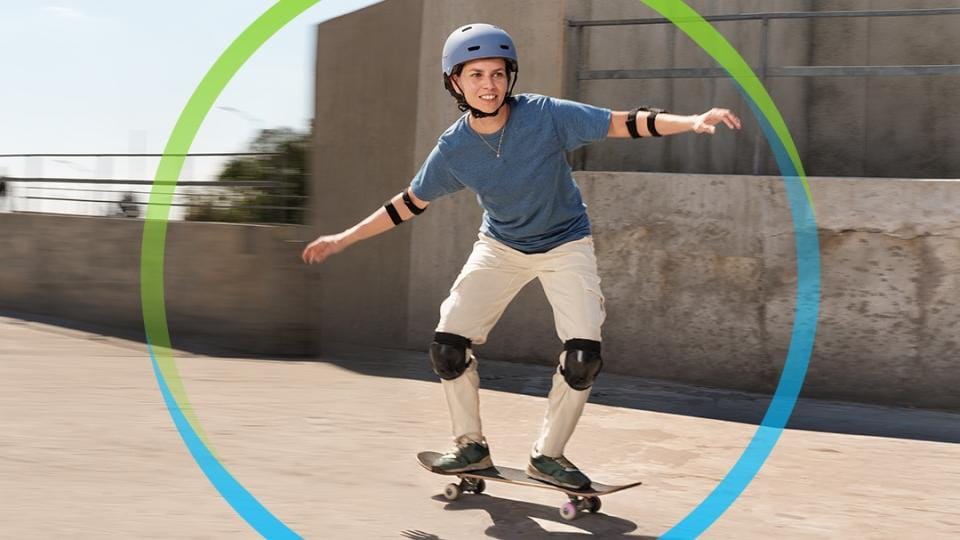Treating Athlete's Foot - a Common Condition for Swimmers

The topic of athlete's feet is not a problem for top swimmer Christian vom Lehn.
Summertime – sunshine and pool parties. Sometimes the only way to escape the oppressive heat is by jumping into the pool. But frequent trips to the swimming pool can lead to an annoying skin problem: athlete's foot. For professional swimmers, it is a particularly common issue.
That moment – when the waves close over his head and the sounds from the outside world become muffled in his ears – always makes him forget everything while he floats weightless in the water. Then he pulls himself together and starts swimming. Length for length, kilometer for kilometer. For hours. Every day. The race is always the same: it’s him against the clock’s second hand. “You could call it a love-hate relationship,” explains Christian vom Lehn. “But although training can be damned hard and I have to force myself to get up early in the morning – I could never give it up.”
Christian vom Lehn is one of Germany’s top swimmers. The 25-year-old recently took first place in his main disciplines, the 100 and 50 meters breaststroke, at the German Championships and thus secured his place in the World Championships team. “Actually, I never consciously intended to become a top swimmer,” shrugs vom Lehn. “It just happened that way.” Vom Lehn has trained at the SG Bayer in Wuppertal since he was a child. The hall in the competitive swimming center in Wuppertal is his second home.
- 1/7
- 2/7
- 3/7
- 4/7
- 5/7
- 6/7
- 7/7







But frequenting public swimming pools comes with the risk of extremely unpleasant problem: athlete's foot, a disease that is very common in professional swimmers. The fungi that cause this infection are particularly at home in the warm, humid conditions in indoor bathing areas and public showers, and can easily survive for several months in these environments. “One single infected person can inadvertently spread fungal spores all over the swimming pool,” explains Matteo Borsa, who is responsible for the Canesten family of products for skin and foot health at Bayer. “People walk barefoot through these spores which can then penetrate the skin.”

The typical symptoms of athlete's foot are easy to spot.
How Does Athlete's Foot Occur?
Approximately 75 percent of all cases of athlete’s foot are caused by the fungal pathogen Trichophyton rubrum, which feeds on keratin, a key substance of our skin, hair and nails. The spores use enzymes to penetrate deep in the horny layer and, thanks to their special structures, attach themselves firmly to the stratum corneum. Healthy skin can defend itself against these attacks, but when it is injured or softened, the fungus can more easily penetrate the skin barrier.
The fungus forms thread-like filaments called hyphae which penetrate the stratum corneum. They then spread and join together into a network.
Athlete's foot generally occurs between the toes where moisture is most likely to accumulate, offering the best conditions for the fungus. However, it can also develop on the sole and arch of the foot.
The risk of infection is highest in places where people frequently walk barefoot, in other words in hotel rooms, fitness studios and public swimming pools. Pools are particularly high-risk areas because of the moisture.
Left untreated, athlete's foot can weaken the skin’s natural defense system to the extent that a Streptococcus infection develops, which manifests itself as erysipelas. This severe skin infection is associated with high fever and necessitates hospitalization.
Christian vom Lehn has experienced it for himself. “It itched between my toes, the skin peeled off, the soles of my feet burned,” he remembers. “I was a teenager and didn’t pay attention to my mother’s warnings to always wear flip-flops at the swimming pool.” Vom Lehn grins. A confident, polite and good-looking man, the topic of athlete's foot is not one that he finds in any way uncomfortable. “It’s no big deal,” he says. “I applied cream to it for a couple of weeks, and that was that.”

Not everybody has such an uncomplicated attitude to fungal infections as vom Lehn. “Many people are embarrassed by this skin disease. After all, there’s a lot of social pressure in our society and people are quick to make assumptions about others,” explains Heiko Petersen, who is responsible for global marketing of Canesten. “Thanks to our broad-spectrum product, affected people can often quickly get rid of athlete's foot and feel happy in their skin again. Canesten is effective against many of the fungal pathogens that cause athlete's foot.” The antifungal product inhibits the growth of fungal pathogens and eliminates them. What’s more, it combats not only the causative agents responsible for athlete's foot but also many of the bacteria that frequently can co-exist with the condition.

Vom Lehn is currently fully concentrated on the World Championships in Budapest. He trains for two hours early every morning before attending his university seminars on media science and then for another two hours in the afternoon after his lectures. He will not have much time for barbecues and garden parties with friends this summer. “But it’s worth it for that fantastic moment when you stand on the podium.” His episode of athlete's foot is a thing of the past. But now he always remembers to take one thing with him to the pool – his flip-flops.




















